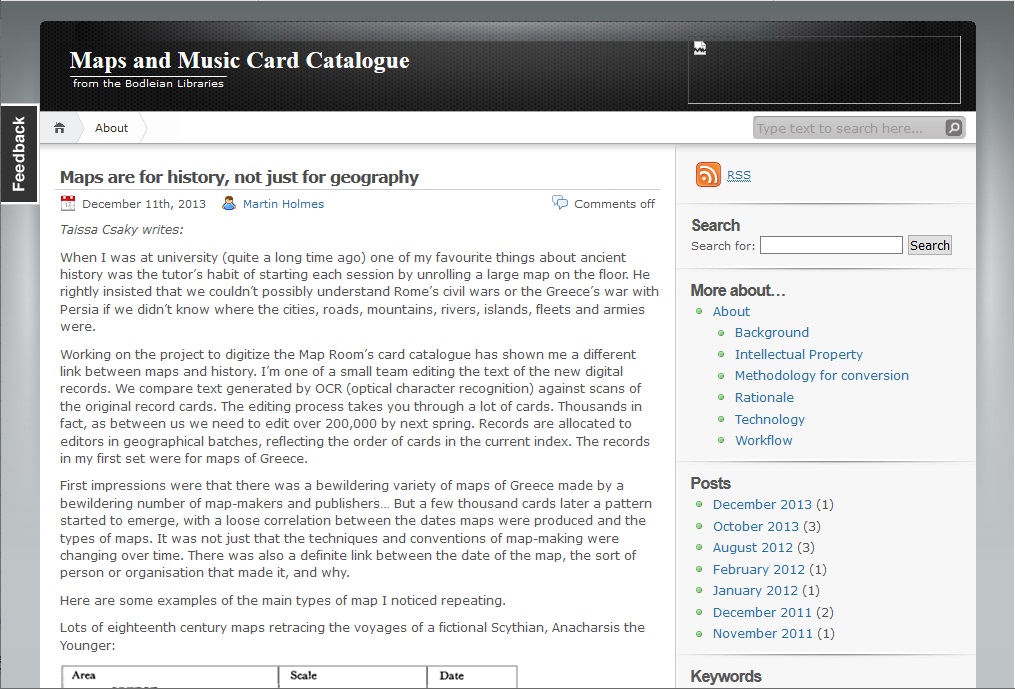
We regret to inform users that this resource is no longer available. The site has been withdrawn as the technologies which it is built with have reached end-of-life.
An archived version of the site is available at https://wayback.archive-it.org/org-467/20190827102323/http://mapsandmusic.bodleian.ox.ac.uk/project/
Last update to original site:
11 December 2013
Date withdrawn:
15 April 2020
Please contact digitalsupport@bodleian.ox.ac.uk with any questions.
Preface from the original site
Conversion of Music and Map Catalogues at the Bodleian Libraries
Summary
As the Bodleian is now developing a series of projects that aim to create an integrated research resource, based on its special collections, of unparalleled scope and depth through a combination of a major buildings renewal programme, a continuing process of innovation in research support activities, and the large scale conversion of both catalogues and the collections themselves into digital form, the time is right to tackle the hidden collections within its holdings.
This proposal focuses on unleashing the research potential of the hidden collections that its legacy holdings of some 536,400 card catalogue records describe. The conversion of these catalogues will be done through a cost-effective means of scanning, rekeying and editing into XML, which will allow the data created through the project to be searchable by both humans and machines. The data will be able to be manipulated through linking and will be searchable in combination with other datasets, even those created to different standards.
The benefits of this 24-month project can be summarised as follows:
- The project will unlock access to these collections for scholars from around the world.
- The conversion of the card catalogues will provide metadata for future digitisation projects
- The resultant catalogue will allow the collections to be managed more effectively than at present.
- The conversion of the catalogues will free up considerable amounts of space for other research purposes in the refurbished Special Collections Library (to be known as the Weston Library)
A further step could be taken which would involve machine-matching the XML records against the WorldCat database using the WorldCat API[1] in order to obtain MARC21 records. The possibility of taking this additional step is currently the subject of a small-scale pilot project between the Bodleian Libraries and OCLC, with results expected in May 2011.
A further category of hidden collection remains: manuscripts. The Bodleian’s extensive collections of Western and Oriental manuscripts are one of the world’s greatest research collections of their kind. The cost of converting the various manual catalogues, in printed, typescript and manuscript form would be the equivalent of the cost of this project, and will therefore form the basis of a separate proposal. We wish, however, for purposes of discussion of the scheduling of a possible follow-on proposal, to make you aware of this pending initiative.
[1] See http://www.worldcat.org/affiliate/tools?atype=wcapi
Background
The Bodleian Libraries have been converting the catalogues of their vast holdings of library research collections into electronic form, and discoverable via the web, for over 30 years. The vast bulk of the catalogues of printed books and journals in western European languages have now been converted, but immense ‘hidden’ collections still remain within the Bodleian’s stacks, discoverable only by researchers able to visit Oxford in person. These hidden collections fall for the most part within the Bodleian’s Department of Special Collections[1] and are known and used by large numbers of scholars in Oxford and beyond who are familiar with the idiosyncrasies of the various manual catalogues and able to come to Oxford with enough time to plan and execute their research projects in situ.
With the patterns of research activity changing and with scholars now increasingly expecting to plan their research in advance of their library visits, when they are unable to consult materials themselves online through digital surrogates, the Bodleian’s approach to these hidden collections has to change.
The main catalogue of the Bodleian Libraries has been in existence in electronic form for 20 years. The Bodleian’s online catalogue, known as OLIS (Oxford Libraries Information System), now has 11 million records for the Bodleian and for over 40 other libraries in Oxford, and has become an increasingly sophisticated search and discovery tool for more than just the physical holdings of the Library.
During the past two years the Bodleian has added a resource discovery layer, SOLO (Search Oxford Libraries Online) to its OPAC, using the ExLibris technology Primo[2]. This provides faceted searching and browsing, and unified resource discovery for OLIS, ORA (the Oxford institutional repository), and for journal articles (through Primo Central), and digital images (eg from Luna databases).
[1] See http://www.bodleian.ox.ac.uk/bodley/library/specialcollections
[2] See http://www.exlibrisgroup.com/category/PrimoOverview
